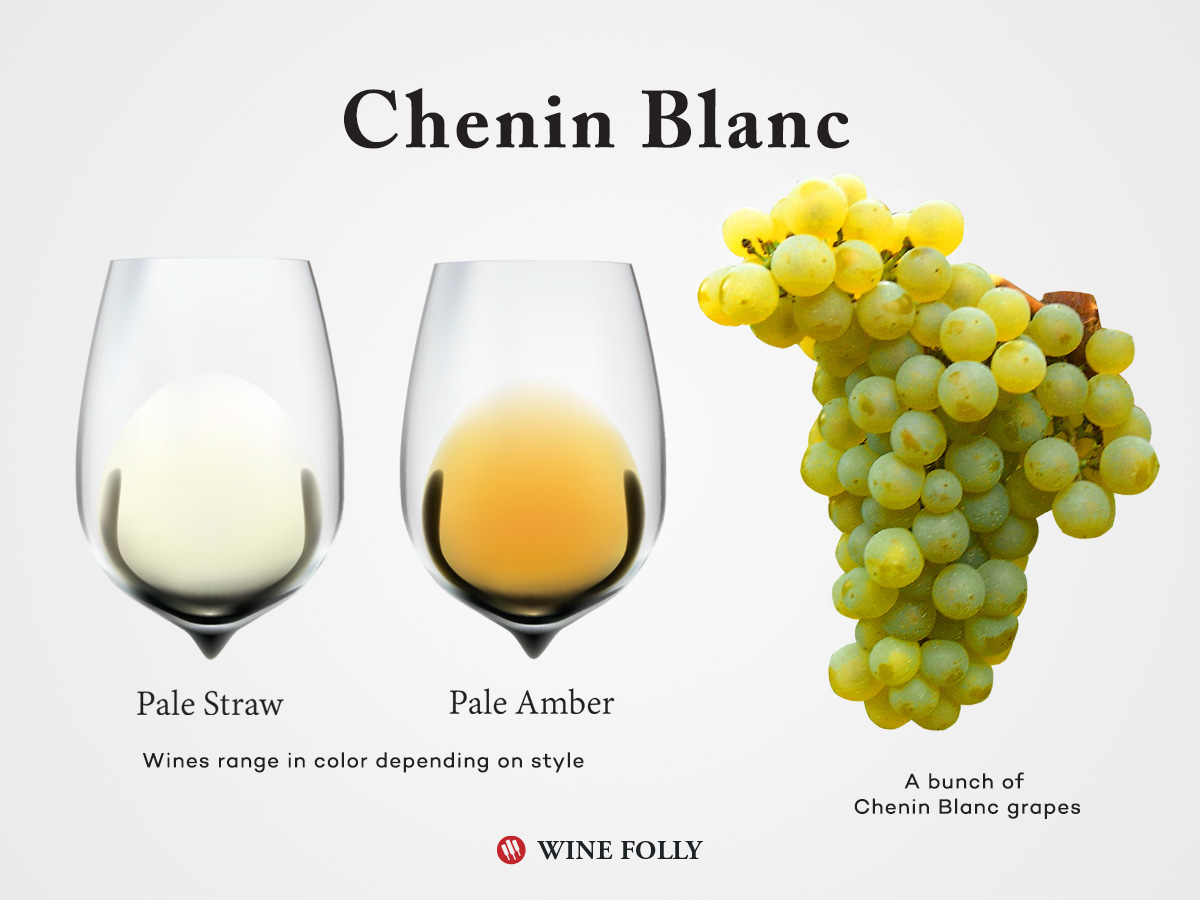It’s hard not to love Chenin Blanc. It is versatile in style and sweetness and has the ability to adapt to a wide variety of tastes.
Chenin Blanc makes lithe, dry summer whites and sparkling wines. It also offers oak-aged styles with similar flavors to Chardonnay. Thus, there really is a Chenin Blanc wine for every occasion.
This guide offers several tips on buying, drinking, and pairing Chenin Blanc like a pro.
Chenin Blanc Wine Profile
Pronunciation:“shen-nin blonk”
Chenin Blanc Characteristics
FRUIT: yellow apple, quince, pear, baked apple, bruised apple, passion fruit, lime, honeydew melon, peach, persimmon, mandarin orange
OTHER: lemon verbena, ginger, honey, honeysuckle, jasmine, chamomile, saffron, apple blossom, coleslaw (oxidative styles), sake, cheese rind(oxidative styles), hay
OAK: buttered popcorn, butterscotch, lemon curd, nutmeg, baked apple, graham cracker, meringue, marzipan, brioche
ACIDITY: medium-plus to high acidity
ABV: 12-14.5%
MAJOR REGIONS:South Africa (over 50% of vineyards worldwide), France, United States, Argentina
87,000 acres / 32,500 hectares (2010)
ALSO KNOWN AS:
grape names: Steen, Pineau de la Loire, regional names: Vouvray, Quarts de Chaume, Bonnezeaux, Savennières
Chenin Blanc Has a Variety of Flavor Profiles
As a white wine, Chenin Blanc has a wide range of flavors. Part of the reason for this has a lot to do with the winemaking style.
- Dry: When the grapes are fermented dry and kept fresh, they produce a very lean, minerally style Chenin Blanc that offers up flavors of tart pear, quince, ginger, and chamomile.
- Off-Dry: When some of the grapes’ natural sugars are left in the wine, you’ll taste richer flavors of ripe pear, ginger, jasmine, passion fruit, and honeycomb.
- Sweet: Sweeter styles of Chenin Blanc have flavors of dried persimmon, toasted almond, mango, ginger, and mandarin orange.
- Sparkling: Sparkling styles can range from dry (Brut) to sweet (Demi-Sec), with Chenin Blanc’s classic characteristics of quince, yellow apple, plum, ginger, and floral notes.
Chenin Blanc Food Pairings
Think Sweet and Sour. Because of Chenin Blanc’s awesome acidity and inherently sweet flavor, you’ll find it pairs well with foods that have a sweet and sour element. Southeast Asian cuisine or pork chops with apples paired with a richer and sweeter style Chenin Blanc will blow your mind.
Hello Turkey Dinner. There are several white wines out there with enough gusto to moisten even the driest turkey. Try a high quality South African Chenin Blanc with your Thanksgiving dinner. It will even handle cranberry sauce like it was born to do so.
Meat Pairings
Veal, Trout, Chicken, Turkey, Pork Chop, Guinea Foul, Halibut, Smoked Salmon, Terrine, Pâte
Spices and Herbs
Cinnamon, Dill, Tarragon, Turmeric, Ginger, Fenugreek, Fennel, Clove, Marjoram, Allspice, Red Pepper Flakes, Cilantro, Cumin, Coriander, Fennel, Macadamia Nut, Peanut, Cashew, Sesame Seed
Cheese Pairings
Soft to semi-firm cow’s milk cheeses, such as triple-cream brie, gruyere, cream cheese, yoghurt and cheddar work very well with Chenin Blanc. Also try herb-crusted goat cheeses.
Vegetables & Vegetarian Fare
Squash, Jicama, Guava, Shallot, Chives, Savoy Cabbage, Yam, Carrot, Cauliflower, Oyster Mushroom, Corn, Red Bell Pepper, Apple, Quince, Pear
Chenin Blanc Wine Regions
South Africa
The largest producer of Chenin Blanc is South Africa.
In South Africa, Chenin Blanc is sometimes blended with Semillon, Viognier, and Marsanne to make a richer-styled wine similar to an oaked Chardonnay but with a sweeter taste. Also in South Africa, Chenin Blanc and Sauvignon Blanc are blended to create a fresh and zesty dry wine.
Loire Valley, France
In the cooler Loire Valley of France, the ripeness of Chenin Blanc can be so uneven that grapes are usually selected by hand in successive passes through the vineyard.
Highly acidic, less ripe grapes make a great base for sparkling wines.
Riper grapes are used in the richly aromatic, off-dry styles.
Finally, at the end of the harvest season, the last grapes picked are affected with noble rot, which concentrates the grapes’ sugars and lends to rich flavors of orange marmalade, ginger, and saffron. These late harvest grapes go into the blending of the famous sweet wines of the region, including Quarts de Chaume and Bonnezeaux.

